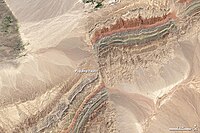
Photo from wikipedia
Abstract This study uses 3D seismic mapping, NNCC attribute analysis and 2D SDEM modelling of soft-sediment deformation to analyse hanging wall deformation related to faulting across a listric fault detaching… Click to show full abstract
Abstract This study uses 3D seismic mapping, NNCC attribute analysis and 2D SDEM modelling of soft-sediment deformation to analyse hanging wall deformation related to faulting across a listric fault detaching along the top of a major salt roller. The computational model experiments used the overall fault and salt-structure evolution as boundary conditions to predict the distribution of faults within the hanging wall. The modelling successfully reproduced geometries similar to the syn- and antithetic faults that are visible on seismics, but it also showed the presence of well-defined vertical deformation zones, both in the hanging wall and the foot-wall of the listric fault. In the model, salt movement controls the formation of the deformation zones. The similarity of NNCC-inferred vertical chimneys and the modelled deformation zones suggests that the subtle vertical chimneys identified in the 3D seismic data might actually be related to vertical to sub-vertical deformation zones caused by the presence and movement of the salt structure.
Journal Title: Journal of Structural Geology
Year Published: 2019
Link to full text (if available)
Share on Social Media: Sign Up to like & get
recommendations!